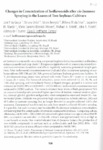Use este identificador para citar ou linkar para este item:
http://www.alice.cnptia.embrapa.br/alice/handle/doc/869923Registro completo de metadados
| Campo DC | Valor | Idioma |
|---|---|---|
| dc.contributor.author | GRAÇA, J. P. da | pt_BR |
| dc.contributor.author | UEDA, T. | pt_BR |
| dc.contributor.author | JANEGITZ, T. | pt_BR |
| dc.contributor.author | SILVA, D. M. da | pt_BR |
| dc.contributor.author | MAEDA, J. M. | pt_BR |
| dc.contributor.author | MORAES, M. C. B. | pt_BR |
| dc.contributor.author | BIRKETT, M. A. | pt_BR |
| dc.contributor.author | PICKETT, J. A. | pt_BR |
| dc.contributor.author | BUENO, A. de F. | pt_BR |
| dc.contributor.author | HOFFMANN-CAMPO, C. B. | pt_BR |
| dc.date.accessioned | 2011-04-10T11:11:11Z | pt_BR |
| dc.date.available | 2011-04-10T11:11:11Z | pt_BR |
| dc.date.created | 2010-12-15 | pt_BR |
| dc.date.issued | 2010 | pt_BR |
| dc.identifier.citation | In: LATIN AMERICAN MEETING OF CHEMICAL ECOLOGY, 1., 2010, Colonia de Sacramento. Abstracts? Colonia de Sacramento: Latin American Association of Chemical Ecology, 2010. p. 126. | pt_BR |
| dc.identifier.uri | http://www.alice.cnptia.embrapa.br/alice/handle/doc/869923 | pt_BR |
| dc.description | cis-jasmone is a naturally-occurring compound in plants that activates direct and indirect defence in model and crop plants'". Exogenous application of cis-jasmone increases flavonoid concentrations in soybean and affects negatively Anticarsia gemmatalis weight gain. Here, foliar isoflavonoid concentrations were evaluated after cis-jasmone spraying on soybean cultivars BRS l34 and lAC 100, grown at Embrapa Soybean greenhouse facilities. At V) development stage, plants were sprayed with water, Tween 20 + water or cis-jasmone + tween 20 + water. For flavonoid extraction, leaves were collected 12, 24, 48, 96, and 120h after spraying, and immediately frozen in liquid nitrogen, ground in a mortar and extracted in MeOH 90% or EtOH 80% + HCI (0.001 M). Isoflavonoid concentrations were estimated by HPLC analysis. The extracts obtained from leaves of both genotypes of 24 h cis-jasmone treated plants presented higher quantities of daidzin, malonyl-daidzin, glycitin, malonyl-glycitin, glycitein and genistin, when compared to water and Tween 20 + water treated plants. Daidzein was present in hígh concentration, in both cultivars, 24 h and 48 h after cis-jasmone spraying, but no longer detected in samples collected 120 h after treatment. Coumesterol was detected, but only from samples collected 48 h after spraying. It is possible that such increases may be related to the decrease in daidzein concentration, considering that this compound is involved in coumesterol synthesis. Comparing solvent efficiencies, EtOH 80% + HCI (0.001 M) presented higher extraction capacity than MeOH 90%; coumestrol concentration in ethanolic extracts was approximately twice as high as in methanolic extracts. Our results indicated that cis-jasmone induces the production of non-volatile compounds in soybean such as isoflavonoids, and that EtOH 80% + HCI (O.OOIM)extraction is more efficient when compared to MeOH 90%. | pt_BR |
| dc.language.iso | eng | eng |
| dc.rights | openAccess | eng |
| dc.subject | Isoflavonoides | pt_BR |
| dc.title | Changes in concentration of isoflavonoids after cis-jasmone spraying in the leaves of two soybean cultivars. | pt_BR |
| dc.type | Resumo em anais e proceedings | pt_BR |
| dc.date.updated | 2017-01-30T11:11:11Z | pt_BR |
| dc.subject.thesagro | Composto fenolico | pt_BR |
| dc.subject.thesagro | Variedade | pt_BR |
| dc.subject.thesagro | Soja | pt_BR |
| dc.subject.nalthesaurus | Isoflavonoids | pt_BR |
| dc.subject.nalthesaurus | Cultivars | pt_BR |
| dc.subject.nalthesaurus | Soybeans | pt_BR |
| riaa.ainfo.id | 869923 | pt_BR |
| riaa.ainfo.lastupdate | 2017-01-30 | pt_BR |
| dc.contributor.institution | JOSÉ P. DA GRAÇA, UNESP; TATIANA UEDA, UNIFIL; TATIANI JANEGITZ, UEM; DÉBORA M. DA SILVA, UEL; JAQUELINE M. MAEDA, UNESP; MARIA CAROLINA BLASSIOLI MORAES, CENARGEN; MICHAEL A. BIRKETT, ROTHAMSTED RESEARCH; JOHN A. PICKETT, ROTHAMSTED RESEARCH; ADENEY DE FREITAS BUENO, CNPSO; CLARA BEATRIZ HOFFMANN CAMPO, CNPSO. | pt_BR |
| Aparece nas coleções: | Resumo em anais de congresso (CNPSO)  | |
Arquivos associados a este item:
| Arquivo | Descrição | Tamanho | Formato | |
|---|---|---|---|---|
| HC1260001.pdf | 501.85 kB | Adobe PDF |  Visualizar/Abrir |









